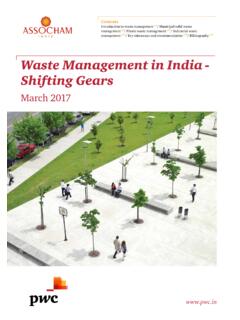Transcription of Addressing Slum Redevelopment Issues in India - Smartnet
1 Dow Sustainability Fellowship 2015: Addressing Slum Redevelopment Issues in India Michelle Hindman, Olivia Lu-Hill, Sean Murphy, Sneha Rao, Yash Shah, Zeqi Zhu Table of Contents Executive Section I: Background on Housing in Section II: Analysis from Field Section III: Administrative Environmental Financial Cultural ACKNOWLEDGEMENTS. We want to say a very big thank you to our collaborators and mentors in making this publication. It wouldn't have been possible without you. Dr. Anne Wallin Dow Fellows Program Coordinator, 2015. Dow Chemical Funding Partners: Dow Sustainability Fellowship International Institute of University of Michigan Advisors: Dr. Vikramaditya Khanna University of Michigan Law School Dr. Pavan Mamidi India Institute of Management, Ahmedabad Dr. Ana Paula Pimentel Walker University of Michigan, Taubman College of Architecture and urban Planning Claudia Wigger University of Michigan, Taubman College of Architecture and urban Planning University of Michigan Schools Represented University of Michigan, Engineering School University of Michigan, Gerald R.
2 Ford School of Public Policy University of Michigan, Natural Resources and Environment University of Michigan, Taubman College of Architecture and urban Planning Executive Summary The main objective of this study is to develop recommendations to improve the Government of India 's Housing for All policy. Apart from the recommendations to policymakers on institutional themes, we also provide recommendations to private sector real-estate developers for designing sustainable low-income settlements. To help us achieve these objectives, we divided our study into three sections: 1. Literature Review of Past Policies in India : In our study of global interventions to improve the quality of life for slum households we categorized past policy approaches into broad categories of slum upgradation or slum Redevelopment . We compared the features of three past federal policies in India namely National Slum Development Program (NSDP), Basic Services for urban Poor (BSUP), and Housing for All.
3 Through our literature reviews and qualitative interviews, we found that in-situ slum Redevelopment policies such as Housing for All present more advantages than past policies. In Section I, we present the analysis of three available policy options based on program features, performance, and achievements. 2. Stakeholder Meetings and Field Visits: Since we found the in-situ component of the Slum Rehabilitation Scheme (SRS) to be closest to the slum Redevelopment component in Housing for All, we targeted this policy in our field research. In our stakeholder interviews we gauged its potential to become an effective model for slum Redevelopment in emerging cities in India . During our visit to Mumbai in May 2015, we met with key stakeholders, including government officials, lawyers, real estate developers, policy makers, and private equity investors to understand implementation challenges of SRS. We also met with advisory agencies and academic experts in Ahmedabad and Delhi to understand scalability challenges for SRS.
4 In Section II, we use these insights to analyze lessons from twenty years of implementing SRS that could be applicable for the Housing for All policy. 3. Recommendations: In the final section, we synthesized our year-long research to distill four key recommendations to improve various types of sustainability of slum Redevelopment . Our recommendations aim to use the field research from Mumbai to narrow down cities where in-situ Redevelopment would be most administratively sustainable. We propose financing models for beneficiaries of these schemes which would ensure formalize property rights for the long term. We propose decentralized waste water and energy amenities to improve the environmental sustainability of housing and cities. Finally, we provide recommendations for architectural modifications which could retain the cultural sustainability of the communities. We aim to disseminate these four key recommendations to policy makers in India so that Housing for All is able to reach the goal of providing decent housing for every slum dweller by 2022.
5 SECTION I: BACKGROUND. 7. Introduction In 2009, for the first time in human history, more people lived in cities than in villages1. This urbanization has been celebrated due to the associated rapid rise in productivity and thereby GDP growth, particularly, in the case of China and South Korea. However, there have been instances of urbanization without growth, such as in Brazil and certain African countries, where the quality of opportunities in cities, rather than the quantity of people, determines economic development2. Decent housing and the supporting urban infrastructure are fundamental drivers of improving quality of life. In 2011, 377 million people (31% of the total population) in India lived in cities, but of these, 65 million (27% of the urban population) lived in extreme shelter poverty in areas called slums. This challenge is not unique to India , 863 million people around the world live in similar squatter settlements3.
6 India and China have the highest number of slum dwellers, with 50 million plus inhabitants living in acute shelter poverty. The United Nations'. Sustainable Development Goals recognize the sustainable growth of future generations is contingent upon active improvement in quality of life. The Sustainable Development Goals aspire to halve the proportion of people living in slums within each country by 2030. Given the very nature of informality , surveying the number of households defined as slums is challenging, but in India this implies improving quality of life of at least 6 million households. Yet, India has a more ambitious target in mind; the government recently announced Housing for All policy which aims to provide every citizen access to adequate housing by 2022. It is estimated that the current shortfall of houses is 19 million, with 95% of this need being in the low-income segment (less than 2,00,000)4. This cannot be achieved by government interventions alone, hence the government has articulated its policy of incentivizing the private sector to participate in effective Redevelopment of the entire slum community.
7 The slum Redevelopment component of this scheme proposes an efficient solution: the government aims to use land occupied by squatter settlements as a resource to subsidize housing for urban poor. This effectively solves the problems of land shortage while subsidizing the cost of housing for urban poor to as little as zero in some cases. By involving the private sector and using real-estate as a financing tool, this component of the policy marks a stark departure from the previous policies which focused on piecemeal upgradation efforts in slums (National Slum Development Program) or used government machinery to create poor quality public housing (Basic Services to urban Poor). Our research has found strong similarities between the federal Housing for All scheme's slum Redevelopment component and the state policy implemented in Maharashtra (Slum Rehabilitation Scheme). This paper has used performance of in-situ Redevelopment component of SRS as a proxy to predict the future performance of Housing for All's slum Redevelopment component.
8 We have then compared the features of three national schemes - NSDP, BSUP, and Housing for All - to develop an understanding of which policies have worked best in the Indian context. Section I: Background on Housing in India Snapshot of Indian Slums The 2011 census presented the first quantitative picture of assets and amenities in informal housing units, which had until then been undocumented. This data presents important information about social, financial, and political attributes of slum blocks and of individual slum households. This context will be helpful in understanding the needs of slum households and the high levels of density in such areas. The census estimates the number of slum blocks in the country to be 110,000. While the number of households in each of these slum blocks varies between 86,000 households in Dharavi5, to 1,300 households in Nochikuppam Chennai6, the level of public services in these areas remain visibly poor everywhere.
9 There are several reasons for such low level of services, including a low tax base of urban local bodies, poverty debt traps, and a lack of informed voting. Among the slum blocks: 58% have open or no drainage 43% must bring water from outside their communities 26% do not have access to clean drinking water 34% have no public toilets in their communities 2 electricity outages occur per day Image and Information Source: Indian Government Census, 2011. Box 1. Snapshot of Slum Blocks in India Local governments in India operate with very low tax bases, where eight of the largest twenty-one cities, are unable to finance even 50% of municipal costs7. As a result, informal districts of the city are worst-hit by low service levels. If the slum population is largely informal and tax non-compliant, local governments see little incentive to spend money on increasing their service levels. This is evident in visible open drainage lines, and lack of streetlights, roads, household toilets, and garbage collection services.
10 This has led to major public health Issues such as open defecation and the presence of unsanitary waste adjacent to houses8. Various studies correlating health outcomes to the built environment found that children living in urban slums in India have stunted growth compared to non-slum urban and rural children9. The health effects on slum residents have shown to vary by several factors including number of years living in the slum, presence of a separate kitchen, type and permanence of the shelter. The extremely dense housing also causes communicable diseases to spread rapidly. In cities where the slum population constitutes about 40% of the total population of the city, one would expect the large slum representation to result in greater political demand for basic services. Unfortunately, large electorate numbers have not been able to translate that potential into a political advantage resulting in better service levels.









